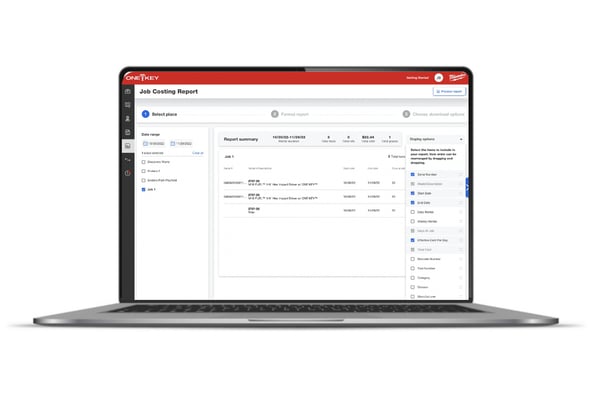
There are many meanings of construction turnover. But what is a good inventory turnover?
In this article, we discuss:
Inventory Turnover Meaning: What Is Inventory Turnover?
A conference paper, “Improvement of the material and production resources control in the construction industry (5)," describes inventory turnover as the usage of the “average inventory balance over the analyzed period.”

“This indicator characterizes the quality of stocks,” they add, explaining that “effectiveness of [inventory management] allows you to identify the remains of unused, obsolete or substandard stocks […] due to the fact that profit arises with each ‘turnover’ of stocks (ie, use in production, the operating cycle.”
Inventory turnover of tools and equipment may stem from poor management—whether due to inadequate service/maintenance leading to degraded equipment lifespan, poor scheduling/resource management leading to depletion of stock in peak times requiring additional spend to meet workforce needs, unexpected equipment-related construction downtime, etc.
What Is a Good Inventory Turnover? Calculating Inventory Turnover Days Depends on Industry
Findings by Saidova et al (5) revealed, “The shelf life of inventory items increased by 1 day in 2018 compared with 2017, and in 2019 compared with 2018 increased by 5 days and amounted to 10.21 days.”
Netsuite by Oracle averages “between 5 and 10 days” for most industries as an “ideal” inventory turnover ratio “meaning the company will sell and restock inventory roughly every one to two months.” Industries with perishables (like florists and grocers) will have a higher ratio to prevent inventory losses due to spoilage, they add.
However, as Investopedia notes, inventory turnover and how it’s measured varies by industry—for example, in “some industries, low inventory turnover can indicate bad management, poor purchasing practices or selling techniques, faulty decision-making, or the buildup of inferior or obsolete goods.”
In industries like construction, turnover and how it’s measured will certainly differ dramatically compared to other industries. For example, tool room managers will likely want to limit the number of days equipment sits onsite unused – tool management reporting can help identify instances where orphaned tools may sit unaccounted for onsite costing you money. Not unlike retail or perishable industries such as grocers—where “Just-in-Time”(JIT) manufacturing dictates getting supplies to where they’re needed, as they’re needed, to avoid excess supply sitting on shelves needlessly—construction seeks to cut down on unnecessary overhead by adopting similar lean construction principles.
Inventory Turnover Benchmark by Industry
CSI Markets ranks the top 10 inventory turnover ratios by industry:
| Ranking |
Ranking |
Ranking (average) |
| 1 |
Financial |
48.76 |
| 2 |
Services |
28.47 |
| 3 |
Transportation |
14.15 |
| 4 |
Technology |
11.21 |
| 5 |
Retail |
10.86 |
| 6 |
Utilities |
10.44 |
| 7 |
Energy |
8.20 |
| 8 |
Consumer Discretionary |
6.86 |
| 9 |
Basic Materials |
6.77 |
| 10 |
Consumer Non-Cyclical |
6.70 |
Inventory Turnover Ratio
Finding an inventory turnover ratio that works for your industry is critical – an exhaustive literature review in the TQM Journal of nearly 500 studies on the subject (4) concluded that “IM (inventory management) highly correlates with the inventory turnover ratio.”
Investopedia offers the following inventory turnover calculation ratios:
- Inventory Turnover = Sales / Inventory
- Inventory Turnover = Cost of Goods Sold (COGS) / Average Value of Inventory
Furthermore, academic studies offer additional analysis of inventory turnover ratios used across industries like manufacturing and construction (1, 2, 3, 4, 5, 6).
How to Reduce Inventory Turnover
“System of inventory management relate to logistics,” write Saidova, M. et al (5), explaining:
“Being a logistics approach to management of material flows is the integration of separate participants of the logistics process in a single system that can quickly and economically deliver the required goods to the right place. The difficulty here is that within a single logistics system it is necessary to combine different owners, i.e. entities with different economic interests.”
True, inventory strategies in the construction industry include “just-in-time” principles to get tools to the job as they’re needed. Improving inventory data to limit outdated information is also critical, as is building interoperability in software systems to improve cross-functional collaboration and communication, breaking down information silos.
In order to reduce inventory turnover, Ekenyong et al (1) write, “Effort should be made to decrease the number of inventory turnover days and increase the creditors’ payable days in order to minimize the length of the working capital cycle for increase financial performance.”
“Efficient inventory control measure like storing and transferring stock, as well as tracking should be put in place for enhance financial performance,” they add.”
Inventory turnover markedly decreases with the implementation of an inventory management system – one conference paper for Materials Science and Engineering (5) found that such implementations could reduce “the duration of the production cycle […] by 10%, production costs […] by 5%, significantly increase flexibility in production,” reduce “the time of delivery of objects […] by 2 times,” as well as lead to an “optimized inventory turnover ratio.”
Writing for the Journal of the Korean Society of Civil Engineers (3), researchers explain, “the life expectancy […] for construction equipment reflects respective management status for equipment and will help efficient management for companies.”

Examples of tools to manage inventory while reducing turnover include:
- Automating equipment logistics via a cloud-based inventory system which offers several advantages and features – digital tool transfers, for example, can be set up in advance, synced in the cloud to remove the hassle of paper-based record keeping, and kitted in bulk sends to help streamline shipping and receiving (e.g., a centralized “kit” barcodes/asset ID tag scan can initiate a digital audit via a mobile app, which can be checked against in real time.
- Physical inventory trackers—like Bluetooth® tags—can be assigned at the item-level to track each tool to the field, onto the job in a worker’s hands, and back into the kit following a job. GPS trackers, meanwhile, can be assigned to fleet vehicles to maintain continuous visibility to these assets as they’re transferred from site to site in real time. Learn more: Bluetooth vs GPS for Tool Tracking.
- Construction job costing methods – where tool managers can apply rental rates and, when these tools are transferred to the jobsite, ONE-KEY™ can calculate the cost accrued for each day those items are in the field.
Bottom Line
Addressing inventory turnover can be a moving target in the construction industry as managing numerous ongoing projects can require a certain degree of finesse. Fortunately, making calculations manually with the old school pen-and-paper route is a thing of the past. Tools like job costing introduce features like “smart sheets” to calculate equipment rentals automatically and reporting features to optimize profitability tracking, improve construction forecasting, and prevent construction overruns.
A continued rise for life cycle costing to maximize value for money by evaluating all costs incurred over the whole project lifespan (7). Staying profitable in 2023 and beyond starts with digitization and working leaner as workforce challenges are expected to continue.
References
- Ekenyong, E., Ohaka, J, and Chukwu, G. (2023). Inventory management and financial performance listed construction companies in Nigeria. IIIARD International Journal of Economics and Business Management. 9(3), 41-51. https://www.iiardjournals.org/get/IJEBM/VOL.%209%20NO.%203%202023/INVENTORY%20MANAGEMENT%20AND%20FINANCIAL.pdf
- Kwak, J. (2019). Analysis of inventory turnover as a performance measure in manufacturing industry. Processes 7(10), 760. https://doi.org/10.3390/pr7100760
- Lee, Y and Min Kim, C. (2012, 09). The life expectancy making model for construction equipment. Journal of the Korean Society of Civil Engineers 32(5D) https://doi.org/10.12652/Ksce.2012.32.5D.453
- Mahajan, P, Raut, R, Kumar, P, and Singh, V. (2023, 03). Inventory management and TQM practices for better firm performance: A systematic and bibliometric review. The TQM Journal. https://www.emerald.com/insight/content/doi/10.1108/TQM-04-2022-0113/full/html
- Saidova, M. et al (2020). Improvement of the material and production resources control in the construction industry. IOP Conf. Ser.: Material Science and Engineering, 919(042001). https://doi.org/10.1088/1757-899X/919/4/042001
- Vidhyapriya, P, Mohanasundari, and M., Sundharesalingam, R. (2020, 03). Behavioral analysis of inventory turnover. International Journal of Scientific & Technology Research 9(3), 3546- 3553, https://www.ijstr.org/final-print/mar2020/Behavioural-Analysis-Of-Inventory-Turnover.pdf
- Heralova, R. (2017). Life cycle costing as an important contribution to feasibility study in construction projects. Creative Construction Conference. 196 (2017) 565 – 570. https://doi.org/10.1016/j.proeng.2017.08.031